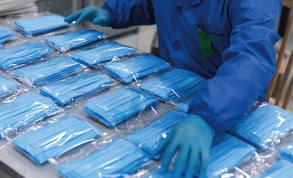Covid items accounts guidance issued
 The NHS England and NHS Improvement document is not an accounts direction, and it will be expanded over the coming weeks to cover further topics. It also gives some pointers to upcoming additions to the Department group accounting manual.
The NHS England and NHS Improvement document is not an accounts direction, and it will be expanded over the coming weeks to cover further topics. It also gives some pointers to upcoming additions to the Department group accounting manual.
The accounting treatment of personal protective equipment procured by the Department of Health and Social Care will ensure trusts’ bottom line is unaffected. Where trusts are treating consumables as inventory, where items are received and used in the same period, the ‘gain’ in income will be balanced with a utilisation charge to expenditure. If items are used in a future period, the non-cash income and expenditure charge will be recognised in different periods and removed from trusts’ adjusted financial performance – the basis of revenue performance on which trusts are held to account.
Where a trust’s consumables inventory is not material and purchases/receipts are charged to expenditure, the ‘gain’ in income will equal the amount in expenditure.
The guidance also includes details of what trusts should do if the market prices of items in inventory are lower than the cost incurred by the Department.
Trusts should consider how they intend to meet the requirement of assuring themselves that their year-end inventory balances are accurate, this will be used by auditors to assess how much reliance they can place on the trust’s arrangements.
As a first step trusts should determine whether their year-end inventory is likely to be material. They will need to consider what arrangements they can put in place to undertake stock counts.
All NHS bodies will be provided with information to allow them to understand the impact; to compare their information on what they have been given with the Department’s data.
They should also discuss with auditors potential alternative procedures where it is difficult to count items, such as in clinical areas. Further guidance will be issued closer to year-end.
During the pandemic, both the Department of Health and Social Care and NHS England loaned medical equipment such as ventilators to trusts to help treat as many patients as possible. Trusts obtain the economic benefits from use of this stock and the equipment is only taken back into the national loan pool with the trust’s agreement. So, items held by trusts on 31 March should be recorded in their accounts, but this will not affect trusts’ overall position.
The equipment is made available free of charge so items held are donations and should be treated as such – the guidance said this will be confirmed in the Department’s group accounting manual. Established accounting for donated assets should be followed.
Items with a value of more than £5,000 should be capitalised as donated assets, while those below the £5,000 threshold should be charged to operating expenses. In both cases an equivalent non-cash gain is recognised in income.
The Department will provide each trust with a list of items and their values by the end of this month. Information on the processes to be followed for equipment provided by NHS England will be added to the guidance later. The donation process will be completed in 2021/22.
The guidance also covers the accounting treatment of Nightingale premises. Some trusts are making peppercorn payments, so its interest in the facility is an operating lease. This commitment should be disclosed, but the payments will be immaterial to the accounts and could be omitted, the guidance says. Other trusts are not making payments so there is no lease arrangement and no transaction to be recorded in the accounts.
Though the Nightingale premises will not be recognised as assets on trust balance sheets, and no significant lease payments or commitments will be disclosed, the national bodies consider the facilities to be material. With this in mind, the Department’s group accounting manual is likely to mandate a disclosure in host trusts’ annual reports and accounts giving information about the Nightingale facilities. This is being developed and the requirements are likely to be at a high level and consistent with figures already provided in the provider finance return forms.
Related content
We are excited to bring you a fun packed Eastern Branch Conference in 2025 over three days.
This event is for those that will benefit from an overview of costing in the NHS or those new to costing and will cover why we cost and the processes.